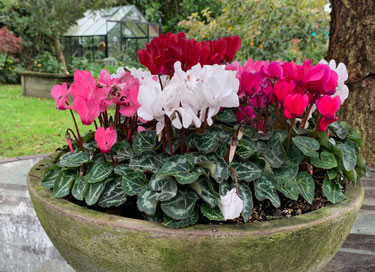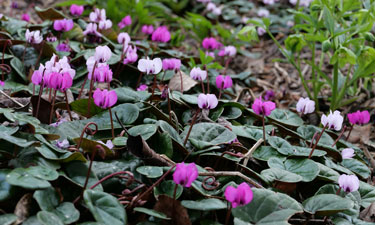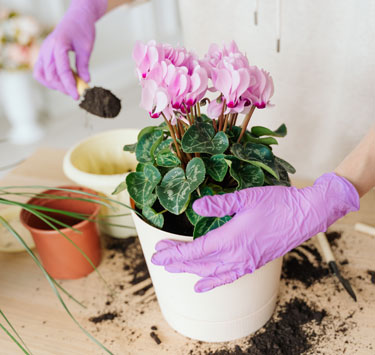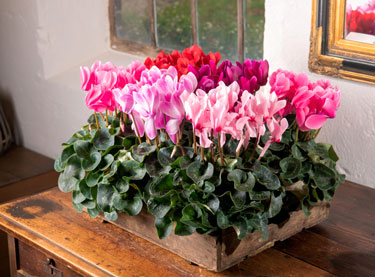Grow cyclamen
Stars of the season
As the days get shorter it makes sense to bring nature closer, making the most of potted plants in and around the home. Bursting onto the scene in autumn with their bright clear colours and stunning flower forms, cyclamen are highlights of the season, both indoors and out.
Potted cyclamen will instantly brighten a room or make a welcoming scene at the front door. Indoor cyclamen are mainly the larger flowered hybrids. These can also be grown outdoors, but the smaller flowered cyclamen are generally the most weather resistant.
A bowl of mini cyclamen on an outdoor table will provide enticing colour for months, provided they receive protection from heavy rain, frost and hot sun. Cyclamen also make beautiful gifts in colours to suit any décor, in many shades of pink, red and white including bicolour forms.
Cyclamen are members of the primula family. The bare stems of their flowers and pretty marbled leaves rise from fat, disc-shaped tubers (sometimes called corms). Today’s cyclamen are the result of extensive plant breeding and the quest for free flowering plants with bigger brighter blooms.
Wild things
Wild cyclamen species originate mainly from the Mediterranean and the Middle East, where summers are hot and dry and winters are cool and wet. Of the 23 different species, some are sweetly scented. And compared to modern hybrids, they have small dainty flowers. Most are summer-dormant perennials with fresh leaves and flowers sprouting in autumn and continuing through the winter before dying back in spring for another summer rest. After pollination, the flower stems curl downwards sinking the seed pods into the ground before releasing their brown sticky seeds. Wild cyclamen are dispersed by ants and other insects, which carry the seeds off to dine on the sticky coating.
Though not as well-known as our showy pot plants, a number of wild cyclamen species exist in New Zealand gardens. The species Cyclamen hederifolium (aka Cyclamen neapolitanum or ivy leaf cyclamen) is a hardy woodland species often seen carpeting shady ground under trees in large established gardens where it is left to self seed. The dainty flowers pop up in late summer and autumn after a period of summer dormancy.
The wild ancestor of most modern forms is Cyclamen persicum, a native of rocky hillsides and woodlands around the Mediterranean. This species was cultivated in French gardens since the early 1700’s. Breeding took off in the mid-nineteenth century.
Cyclamen care
Cyclamen are much tougher than their exquisite looks suggest, and their ancestral homelands of cold winters and dry summers give clues to their preferences:
A well lit location
Place in bright light, away from direct sun. Indoors, an unheated room is ideal, as cool temperatures prolong flowering. Outside, they will grow nicely in bowls and the garden if in well-drained soil.
On the dry side
Keep the potting mix moist but not wet. Watering from the base of the plant, via the saucer, avoids wetting the corm, which is susceptible to disease. A yellow leaf is the first sign of too much water. If this happens, let the potting mix dry out for a couple of weeks (not to wilting stage), then resume cautious watering. A thirsty cyclamen plant will shed its lower leaves and flowers, but retain the newest leaves, which are most vital for survival.
Grooming
Remove spent blooms by holding the stem close to its base and giving a sharp tug to break it cleanly from the corm. Decaying left over stems invite disease.
After flowering
At the end of winter the flowers and leaves die down. You can keep your cyclamen plant going if the tuber is kept dry. Put the pot outdoors for summer, turned on its side. In autumn repot into fresh potting mix and resume watering. Once the leaves appear, feed fortnightly with diluted liquid fertiliser until the flower buds begin to form.

1-Mar-2025

Cyclamen grow well outside - these in a bowl in the shade of a deciduous tree

Cyclamen species forming a ground covering carpet

Repotting cyclamen plant


